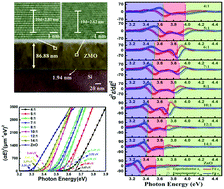Evolution of optical properties and electronic structures: band gaps and critical points in MgxZn1−xO (0 ≤ x ≤ 0.2) thin films†
Abstract
MgxZn1−xO (ZMO) thin films with tunable Mg content were deposited by atomic layer deposition (ALD) on silicon substrates at 190 °C. The elemental and structural properties were acquired by X-ray photoelectron spectroscopy, transmission electron microscopy, atomic force microscopy and X-ray diffraction. Spectroscopic ellipsometry measurements were performed to reveal the evolution of the dielectric functions and critical points in the ZMO thin films by point-by-point fit in the photon energy range of 1.2–6.0 eV. The dependence of the dielectric functions on doping content is clearly demonstrated and physically explained. The critical point energies and the types of interband optical transitions were extracted from standard lineshape analysis of the second derivatives of the dielectric functions. The critical point features were discussed in terms of band structure modification and structural homogeneity arisen by introducing the Mg dopant into the films. Controlling these transitions by changing the doping content will be of practical significance in emerging ZMO-based thin-film photonic and optoelectronic devices.



 Please wait while we load your content...
Please wait while we load your content...